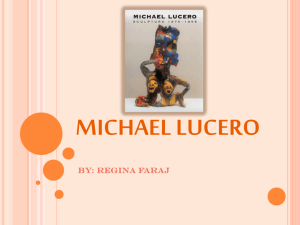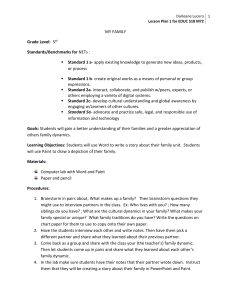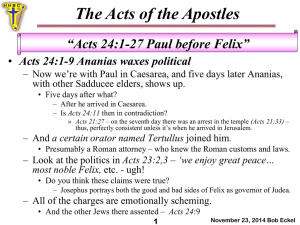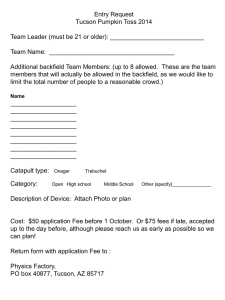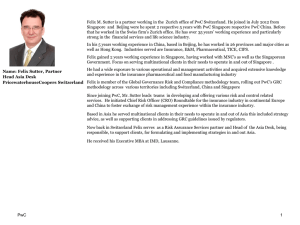MS Word DOCX - Salvador Foundation
advertisement
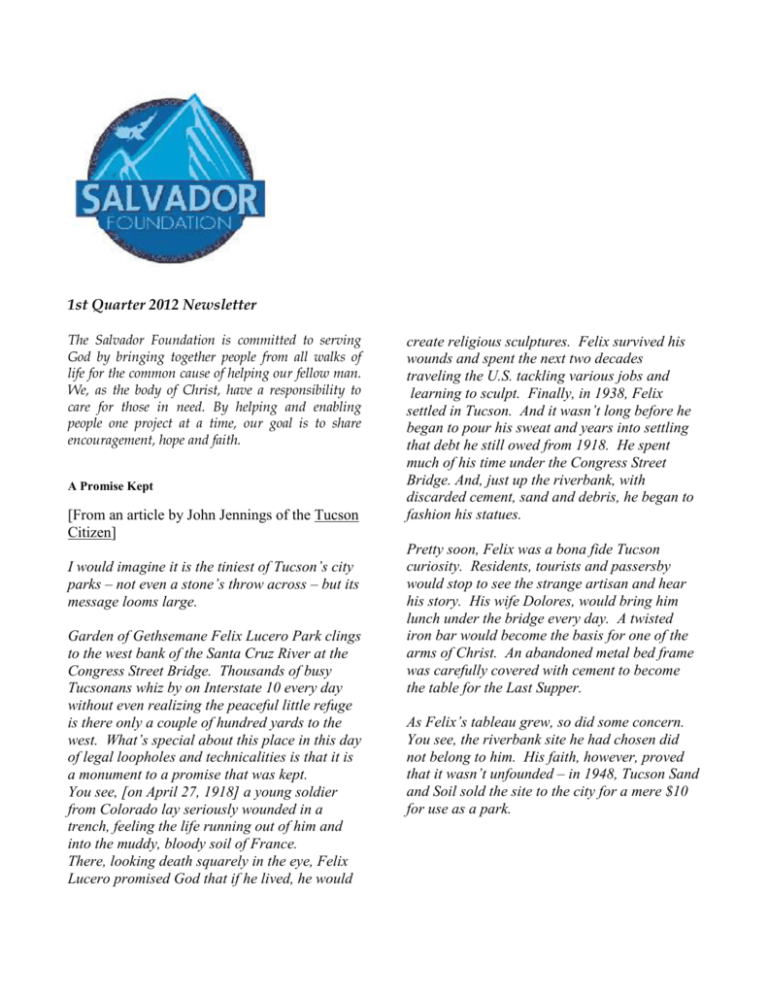
1st Quarter 2012 Newsletter The Salvador Foundation is committed to serving God by bringing together people from all walks of life for the common cause of helping our fellow man. We, as the body of Christ, have a responsibility to care for those in need. By helping and enabling people one project at a time, our goal is to share encouragement, hope and faith. A Promise Kept [From an article by John Jennings of the Tucson Citizen] I would imagine it is the tiniest of Tucson’s city parks – not even a stone’s throw across – but its message looms large. Garden of Gethsemane Felix Lucero Park clings to the west bank of the Santa Cruz River at the Congress Street Bridge. Thousands of busy Tucsonans whiz by on Interstate 10 every day without even realizing the peaceful little refuge is there only a couple of hundred yards to the west. What’s special about this place in this day of legal loopholes and technicalities is that it is a monument to a promise that was kept. You see, [on April 27, 1918] a young soldier from Colorado lay seriously wounded in a trench, feeling the life running out of him and into the muddy, bloody soil of France. There, looking death squarely in the eye, Felix Lucero promised God that if he lived, he would create religious sculptures. Felix survived his wounds and spent the next two decades traveling the U.S. tackling various jobs and learning to sculpt. Finally, in 1938, Felix settled in Tucson. And it wasn’t long before he began to pour his sweat and years into settling that debt he still owed from 1918. He spent much of his time under the Congress Street Bridge. And, just up the riverbank, with discarded cement, sand and debris, he began to fashion his statues. Pretty soon, Felix was a bona fide Tucson curiosity. Residents, tourists and passersby would stop to see the strange artisan and hear his story. His wife Dolores, would bring him lunch under the bridge every day. A twisted iron bar would become the basis for one of the arms of Christ. An abandoned metal bed frame was carefully covered with cement to become the table for the Last Supper. As Felix’s tableau grew, so did some concern. You see, the riverbank site he had chosen did not belong to him. His faith, however, proved that it wasn’t unfounded – in 1948, Tucson Sand and Soil sold the site to the city for a mere $10 for use as a park. The Last Supper and the Crucifixion Felix Lucero and one of his Statues Three years later, having created sculptures of the crucifixion, the Last Supper, Christ in the tomb and the Holy family, Felix died. Twenty years after his death, his concrete creations were moved slightly downstream when the new Congress Street Bridge was built. And 10 years after that, they were moved again – about 50 feet northwest, to protect them from floodwaters and to allow a nice wall and patio to be built around them. Last Supper showing table made from metal bed frame These days, the park is open every day from midmorning to midafternoon, and has become a favorite spot for weddings and quinceañeras (a celebration of a girl's fifteenth birthday in Latino communities). However, in the roughly 75 years since Felix Lucero started his life’s work under the Congress Street Bridge, the sculptures have become victim of decades of weather and vandalism. Recently, the Salvador Foundation funded the Knights of Columbus of Tucson to restore the sculptures to their original condition. The artist chosen for the restoration, Greg Schoon, will faithfully restore the original designs of Lucero based upon old photographs. However, in doing the restoration, the artist will make use of new materials (adhesives, paints) to coat the final works and better protect them from the effects of time and weather. The Garden of Gethsemane restoration will be a two-year effort, but examples of some of the restoration done so far are shown below. A historical timeline of Lucero’s life and the Garden of Gethsemane follows the photos. Before / after head of Judas damaged by weather and vandalism Before / after of Felix Lucero damaged by weather 1938 Felix A. Lucero arrived in Tucson, of Native American descent and a native from Colorado. He made a 20 year commitment to God to sculpt the last supper if he lived through World War I. He started with large sand sculptures under the West Congress Bridge on the eve of Good Friday. Cost of the materials and his family expenses are met by contributions tossed into a blanket by spectators. Thereafter, a storm destroyed work, and he then started creating concrete statues. 1946 Garden of Gethsemane is completed. 1948 Land holding religious statues is given to City by White 1950 Felix Lucero is severely burned on his face and body and his home was burned down to the ground as a candle ignited his mattress. Before / after foot damaged by weather 1951 Felix Lucero weds after a 10 year wait on January 12, 1951. 1951 Felix Lucero passes away on January 24, 1951 of a stroke at the age of 55. 1970 Concrete statues moved for the widening of Congress Street. 1971 Vandals decapitated the 13 figures, destroyed one station, damaged other figures and attempted to set fire to the cross. The fourth time in 20 years the statuary has been vandalized – also defaced by vandals in 1951, 1958 and again in 1965. Volunteers helped to rebuild the damaged figures. 1981 The Knights of Columbus assist the city in the care and maintenance of the statuary and small park area. Work commenced immediately with volunteers from the assembly and from various councils of Tucson. Statuary had to be sand-blasted and repaired before any painting could be done. 1982 June 13, 1982 at the dedication ceremony, Felix Lucero was honored and Dolores Lucero received a scrapbook of newspaper clippings. Statues were moved again to allow for flood-control project. They were moved 50 feet northwest of it’s former site on the west bank. A ceremony was held to bless the park. One year after the move a flash flood occurred which would have washed away the statuary if it hadn’t been moved. 1988 Felix Lucero’s wife, Dolores Lucero, died at the age of 93. Mrs. Lucero would visit the shrine regularly to pray and clean the figures and also try to repair the vandalism. 1989 An article was published “A Battlefield Promise”. In this article Bishop Manuel Moreno of Tucson noted that ‘Felix” means “happy” and “Lucero” means “beacon”. The “Garden of Gethsemane” park, he said, stands out as a happy beacon of how people can work together. A local Fourth Degree Assembly undertook the care of sculpture garden. 1994 A second article was written about Lucero’s promise. In this particular article, Jim Griffith, resident folklorist, tells a tale of a drunken man riding horseback along the Santa Cruz river who came up to Lucero while he was working on the sand sculptures. The drunken man ridiculed the statues before trampling them beneath his horse’s hooves. According to the legend, further down the wash a rattlesnake spooked the horse and the man fell and broke his neck. 2000 A third article was written informing everyone of this “Spiritual Oasis”. It has the what, when, and where along with a map, and the many purposes and reasons why people visit this park. 2007 A fourth article was written about one of Tucson’s Time Capsules. The Salvador Foundation is currently supporting efforts in the US and Latin America. If you would like further information on this or any other activities, please contact: The Salvador Foundation www.SalvadorFoundation.com
